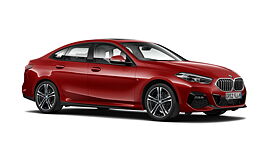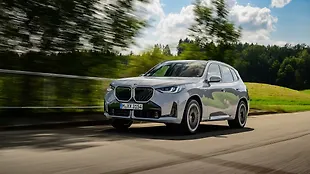Why would I buy it?
- Frugal diesel engine
- Handsome looks and well-made cabin
- Good to drive
Why would I avoid it?
- Cramped cabin not suitable for spending long hours
- India-bound newer version is already out
- Bigger, practical 3 Series isn’t significantly more expensive
What is it?

The BMW 2 Series Gran Coupe is available in India with two engine options, petrol and diesel. Both these engines get two variants – Sport Line and M Sport. We have driven the latter versions for both engines (do click here for the first drive review), and what we have here is the 220d – the diesel in its more affordable variant.

Not only did we spend some considerable time with it this time around, but we also put it through our CarWale test regime. In this review, we will be taking a look at whether or not you should consider buying the 2 Series Gran Coupe – in this 220d SportLine guise.
Is the cabin any good?

In a typical BMW fashion, the cabin of the 2 Series is familiar, ergonomic, and high in quality. But open the frameless doors – in proper coupe styling – and the seat base is quite close to the ground, which means getting inside isn’t very graceful. You’d have to fold your girth, bend the knee, and bow a bit to get in. However, once seated, the cabin layout is subtle. Even though this is an entry-level BMW there’s nothing stingy about the cabin. You get high-quality, soft-touch materials everywhere and a concoction of many textures makes it look smart, but those who want a bit of razzmatazz in their cabin may have to look elsewhere.

Now, the floating touchscreen is a generation old, but the characteristic iDrive control on the centre console means you practically never have to reach for the touchscreen to navigate it. This iDrive control is so easy to operate and once you get used to it, you’d wish every other car had this physical controller.

Then, we like how the seats are a snug fit and draped in high-quality upholstery. However, the white leather upholstery is prone to smudges and will be soiled sooner. But thanks to these light colours used here, the cabin feels roomier. Apart from that, we were happy to see BMW offering an electrically-adjustable driver’s seat with a memory function even in this affordable version.

As we move to the second row, once again we are reminded that getting in this car is a tussle in itself. With a narrow door opening and low-slung roof height, those on a bit healthier side won’t happily agree to get in and out quite often. Even the space is not in generous supply and the bench is best usable for two. Thanks to the scooped-out roof, there’s just enough headroom for my frame at 5.6feet. Even when seated in a relaxed position, with feet tucked underneath the front seats, the awkward seating posture and under-thigh support left us wanting for more. Thankfully, you still get a provision of rear-quarter glass and a large two-pane sunroof which prevents the rear seat passengers from feeling tightly confined. But again, spending cross-country jaunts here wouldn’t be a very comfortable affair.

At 430litres, the boot space of the 2 GC is bigger than the 395litres you get in the Mercedes-Benz A-Class Limousine. Helped by the wide opening and near-square shape of the boot, it’s also practical and can take in ample luggage of four. Pull down the levers in the boot and the 40-20-40 split-folding rear seats expand the boot space, if there’s a need to carry more.

Further, compared to the M Sport variant, this one has a slightly different design for the front and rear bumpers, and there’s no overdose of M badging all around. The alloy wheels are an inch smaller too at 17-inch, with a subtle design which goes well with the 2 GC’s styling. And it also misses out on the BMW-specific 'gesture control' for the infotainment system. Apart from that, all the other features and creature comfort expected in this price range are offered.
Is it nice to drive?

BMW has been using the 2.0-litre turbodiesel with cars wearing the 20d badge for quite some time now and the 220d we have here is powered by the same 188bhp/400Nm unit which is the exact output you get in the larger and heavier BMWs. This transversely-placed four-cylinder is paired with an eight-speed torque converter which sends power to the front wheels. Yes, this 2 Series is based on the same platform as the X1 and the new-gen Mini(s), so it is a four-wheel-drive.

Moreover, having the same output as the 3 and 5 Series in a compact footprint has its upsides. For starters, the engine feels commendably refined and is barely audible at idling whether you are sitting inside the cabin or standing next to it. Only the faintest of vibrations are felt, which remain faint even when the revs rise. We like loads of torque supply from the diesel engine which makes the 2 GC not only eager but also lends it the unpredictable thrust right off the bat that you wouldn’t usually expect from a small-sized sedan.

With our VBox attached, we saw the quickest time of 8.32 seconds in the acceleration run. The 0-60kmph run took just 4.4 seconds which isn’t slouchy by any standards. But more importantly, it’s the in-gear acceleration that was impressive on this 2 Series. It did a 20-80kmph run in 4.99 seconds, and 40-100kmph took just 6.26kmph. These quick times are credited to the ZF-sourced transmission, which is quick-shifting and equally smooth. Under normal driving, the gearbox likes to upshift early and lets the engine sit under 1,500rpm. Meanwhile, at highway speeds, the oil burner churns away around 2,000rpm. And when there’s a need to overtake, the gearbox makes the whole process quite effortless.

If you are opting for the 220d for its outright grunt, you’d be happy to know that another upside to this powertrain is its frugal nature. Under our test routes, the 220d returned 17.46kmpl in the city run and out on the highway it managed a fuel efficiency of 23.87kmpl. With a combined figure of just over 19kmpl and a calculated range of above 900km, the fuel efficiency could be the sole reason to buy it.

Since this Sport Line variant uses an inch smaller wheels with better tyre profile than the M-Sport, the 220d Sportline doesn’t mind those odd bumps and irregularities our roads are filled with. It settles nicely over undulations, but you do get a sense of what’s happening between the rubber and the road surface. Surprisingly, it didn’t scrape over any of the speed breakers we encountered over the four days it was with us, provided you go over them slowly.

Throw it around and you would be hard-pressed to tell that this is a front-wheel-drive. Despite loads of torque supply, there’s no evidence of torque steer. Not only the steering response is quick and direct, but it is also backed up with good grip levels, thus encouraging you to push more and more each time. So, the 220d GC can be a good everyday car, and it can put a large smile on your face when you decide to take an enthusiastic drive over a twisty mountain pass, unending expressways, or intercity jaunts.
Conclusion

If you are ready to spend around Rs 40-50 lakh and find the 3 Series to be a bit of a stretch, the 2 Series with this diesel powerplant makes for a good choice. It might be a snug fit on the inside owing to its compact dimension, but the 2 GC makes up for it with its handsome looks, loads of features, and tons of driving fun.

As for the oil burner, it is frugal and offers the same output you get from the 320d or 520d and also the 20d badged BMW SUVs. Thus, in this lightweight package of the 2, the diesel engine is a special bargain. It’s like seeing Teen Titans arriving at the crime scene when the Justice League couldn’t make it.

Pictures by Kapil Angane

























